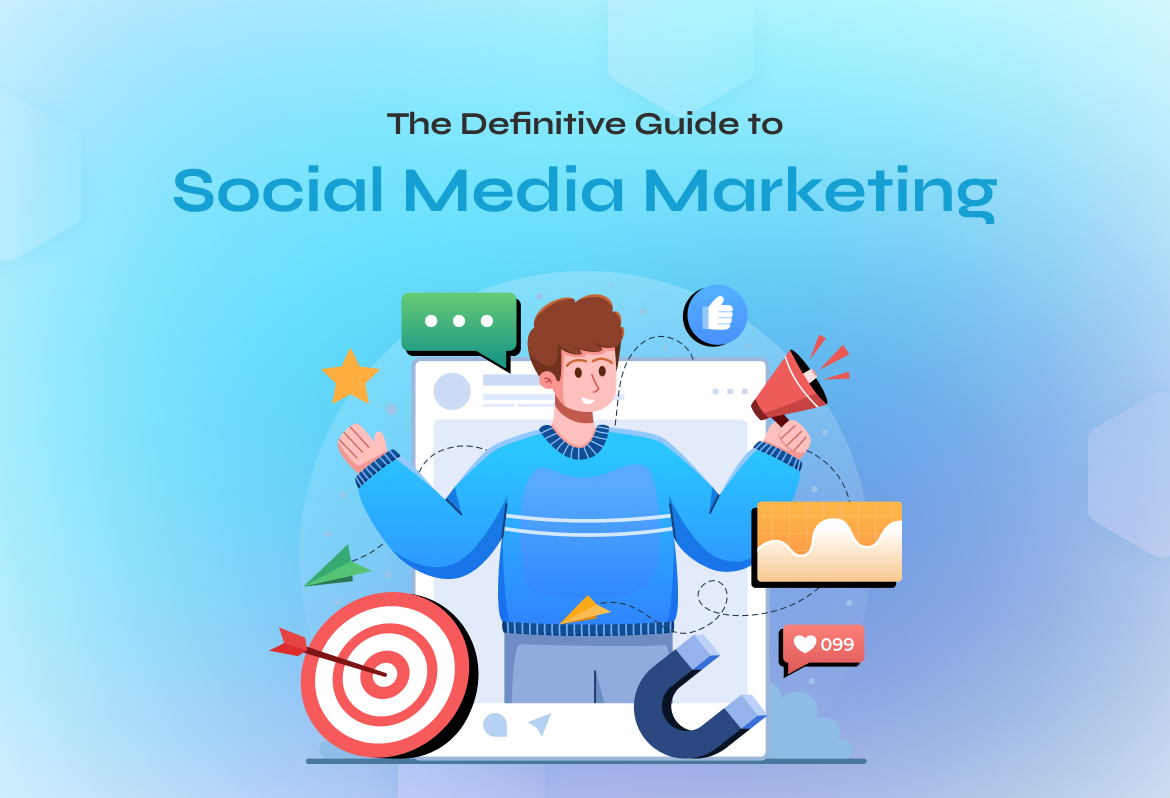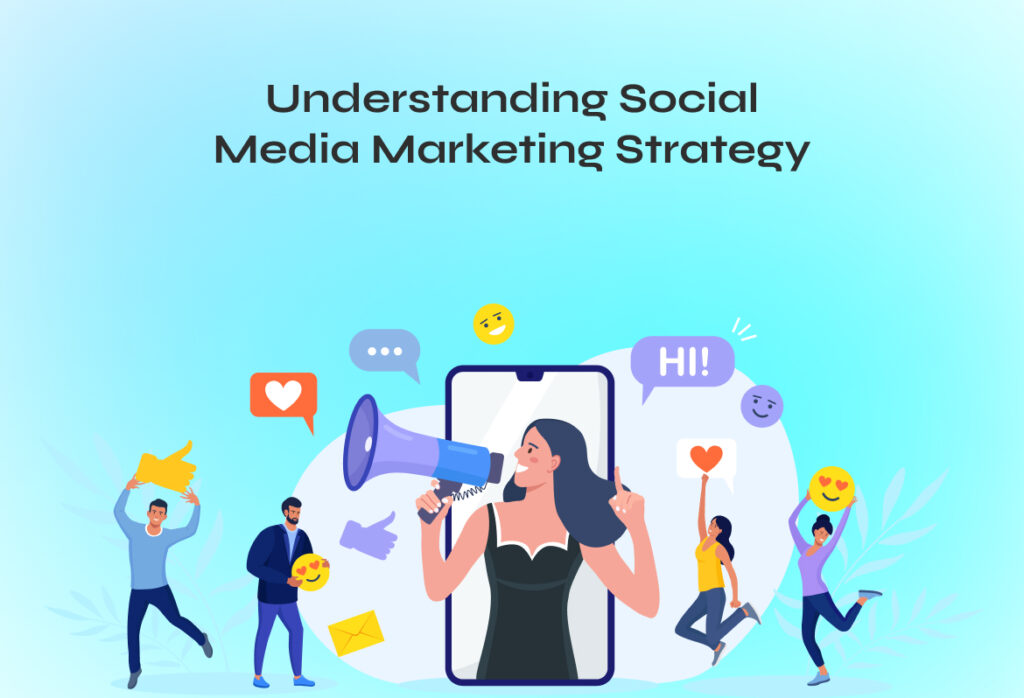Understanding Social Media Marketing
Social media marketing is like having a conversation with your audience through the content you share. It’s not just about posting ads or selling products; it’s about creating stuff – videos, blogs, or even memes – that people find useful, interesting, or entertaining.
The goal is to make your brand feel like a friend they trust and want to hear from. It’s about knowing what your audience likes and giving them more of it so they keep returning to your social media pages for more.
Social media has become quite a powerful tool, emerging as the most commonly used medium where people spend a significant portion of their time. However, it’s crucial to understand what your targeted audience wants to see and what you can offer that they can relate to.
In this article, we will discuss various aspects of social media marketing that can prove beneficial for your business and help get your brand noticed by people who could become your potential customers.
The Importance of Social Media Marketing
Social media marketing is really popular these days. It’s a way for businesses to tell people about their products and services. Why is it so big? Well, because over 4.6 billion people use social media around the world. That’s a lot of potential customers!
Think of social media a place where billions of people hang out every day. By being active on platforms like Facebook, Instagram, or Twitter, you can show off your brand to a massive audience. It’s not just about showing up; it’s about being smart – sharing things that make people like and trust your brand.
When you do it right, social media can make your brand famous, bring in more customers, and even make your current customers love you more.
Another great thing about social media marketing is that it’s way cheaper than old-school marketing methods. It’s not just about saving money, though. Social media lets you talk directly to your customers, get their feedback, and even make your products or services better based on what they say.
Plus, you can reach the right people with targeted ads, which means you’re not wasting time and money showing your ads to people who aren’t interested. All in all, social media marketing is a powerful tool that can really help businesses grow.
Understanding Social Media Platforms for Marketing
Social media platforms can be compared to tools in a toolbox, with each one serving a distinct purpose in marketing. These platforms hold immense potential; according to Statista, 92% of marketers utilize social media for advertising.
However, to execute marketing campaigns strategically and effectively, it’s crucial to understand the unique dynamics of each social media platform. Let’s take a quick look at some of the popular ones:
Facebook:
- Facebook is like a big market where all kinds of people hang out.
- It’s great for all types of businesses because you can find almost everyone here.
- You can use ads, sell things in the Marketplace, or talk to people in groups.
Instagram:
- Instagram is where you go if you want to show off with pictures and videos.
- It’s really good for businesses that have cool stuff to show, like clothes, art, or food.
- Young people and people who like trendy things love Instagram.
Twitter:
- Twitter is like a big chat room. It’s perfect for quick updates or talking about what’s happening right now.
- Businesses use it to share news, handle customer service, or join in on trending topics.
LinkedIn:
- LinkedIn is the office of social media. It’s professional and all about business.
- It’s a good place for B2B (business-to-business) marketing and finding professional contacts.
TikTok:
- TikTok is the new kid on the block. It’s all about fun, short videos.
- If your business wants to reach young people and be creative, TikTok is the place to be.
Pinterest:
- Pinterest is like a bulletin board where you pin ideas and inspiration.
- It’s great for businesses that want to share ideas about things like home decor, recipes, or DIY projects.
Each platform needs a different approach. It’s about finding where your customers are and what they like.
Steps to Excel in Social Media Content Marketing

1. Set a Marketing Goal:
Think of this as setting a target. What do you want to achieve with your social media? Maybe you want more people to know about your brand, or you want more visitors to your website.
Whatever it is, make it clear and figure out how you’ll know you’ve achieved it. It’s like saying, “I want 100 more people to like my Facebook page by next month.” This way, you have something specific to work towards.
2. Know Your Audience:
As technology has advanced and social media has replaced traditional marketing methods, customer behaviors have also evolved. Understanding your audience means knowing their interests and preferences.
By grasping what your audience likes to talk about or see, you can tailor your content to their tastes. Does your audience consist of young people who enjoy humorous memes, or are they professionals who favor more serious, informative articles?
Recognizing these preferences is crucial in creating content that not only resonates with your audience but also encourages their engagement and interaction.
3. Choose the Right Platforms:
When picking a social media platform for marketing, think of it like choosing the best party to go to. You want to be where your customers are. If they’re young and like cool stuff, Instagram is your spot. If they’re more about business and professional stuff, LinkedIn is a better choice.
Facebook is also great because it keeps changing, like adding a marketplace where you can see new brands. So, pick a platform that fits what your customers like. It’s all about being in the right place at the right time.
4. Maintain a Consistent Image and Voice:
This is about making sure your brand sounds and looks the same everywhere. Whether it’s on Instagram, Twitter, or Facebook, your brand should feel like the same ‘person.’ This helps people recognize and remember your brand. It’s like always wearing your favorite hat, so friends spot you easily in a crowd.
5. Use a Content Calendar:
This is like having a planner for your social media. It helps you organize what to post and when to post it. Planning ahead means you won’t be scrambling at the last minute to find something to share. It keeps your social media active and interesting, without the stress of doing everything last minute.
Social Media Content Formats
Each social media platform is unique, like different types of parties. LinkedIn is like a business conference, good for sharing professional advice and success stories.
But if we talk about Facebook, it is like a community gathering, great for sharing a mix of fun and informative stuff.
Instagram is the trendy café, where cool images and short videos are a hit. Twitter is like a newsstand, perfect for quick updates and joining in on the latest trends.
Ever since TikTok took over the internet, it has become the fun street fair, where shorts, catchy videos can make your brand a star.
Knowing these differences helps you create the right kind of content for each platform.
Building Brand Awareness and Recognition
Think of social media as your stage. It’s where you can show the world who you are and what your brand stands for. By sharing things regularly, you become a familiar face to your audience. It’s like being the friendly neighbor everyone knows and likes.
The more people see and interact with your content, the more they’ll remember and trust your brand. It’s about making your brand a part of their daily social media routine, so when they think of a product or service you offer, your brand is the first thing that comes to mind.

Generating Conversations and Understanding Your Audience
Social media is not just about talking; it’s also about listening. When you post something, watch how people react. Do they like it, comment on it, or share it? Their reactions tell you what they enjoy. Also, look at what they’re talking about on their own pages. This helps you understand their interests and problems.
In fact, about 90% of people report that they purchase from brands they follow on social media. This statistic underscores the importance of aligning your content with your audience’s interests and preferences. This ongoing engagement is essential in building a loyal customer base.
To achieve this, create content that sparks conversations, addresses their queries, or provides solutions to their problems. It’s about turning your social media pages into hubs of interesting and relevant discussions.
Driving Traffic and Supporting Content Distribution
Social media can be a powerful way to get more people to visit your website. It’s like handing out invitations to a cool event (your website). When you share links to your blog posts or web pages, you’re inviting your social media followers to check out more stuff on your site.
This can lead to more people learning about what you offer, and even buying your products or services. Plus, it’s not just about new visitors. You can keep reminding people who’ve visited your site before to come back, especially if you’ve got something new and exciting to show them.
Establishing Thought Leadership
Establishing thought leadership through social media involves strategically using platforms like LinkedIn, Twitter, Facebook, Instagram, and others to share insights, ideas, and content that position you or your organization as an expert in a particular field or industry.
It’s about building a reputation that attracts attention, fosters trust, and establishes your authority among peers, customers, and potential clients. Here are several key strategies to achieve thought leadership status via social media:

- Identify Your Niche: Focus on a specific area where you have expertise and can offer unique insights or solutions. This specialization makes it easier to differentiate yourself and attract a dedicated following.
- Consistently Create and Share Valuable Content: Produce high-quality, informative content that addresses the needs, challenges, and interests of your target audience. This can include blog posts, white papers, case studies, infographics, videos, and podcasts. Sharing your knowledge freely helps build your reputation as a go-to resource.
- Engage with Your Audience: Respond to comments, participate in discussions, and engage with your followers and other thought leaders. This interaction not only builds relationships but also fosters a community around your brand.
- Leverage Multiple Platforms: While it’s important to focus on the platforms where your target audience is most active, using a variety of social media channels can help expand your reach and influence.
- Collaborate with Other Thought Leaders: Partnering with other experts for webinars, podcasts, or joint articles can broaden your audience and lend additional credibility to your brand.
- Stay Updated and Relevant: Continuously educate yourself about the latest trends, news, and advancements in your field. Sharing timely and relevant content shows that you’re on the cutting edge of your industry.
- Utilize Analytics: Monitor the performance of your content and engagements to understand what resonates with your audience. Use these insights to refine your strategy and improve your impact.
- Personalize Your Approach: People connect with people, not faceless brands. Show your personality, share your experiences, and be authentic in your interactions.
FAQs
What Exactly is Social Media Marketing?
Social media marketing is the practice of using platforms like Facebook, Instagram, and Twitter to promote products or services. This strategy involves creating engaging content, interacting with followers, and running ads to increase brand visibility, drive web traffic, and generate sales. It’s a versatile approach that allows businesses to reach their audience in a more personal and interactive way.
How Effective is Marketing on Social Media for Small Businesses?
For small businesses, marketing on social media is highly effective due to its cost-efficiency and broad reach. It allows smaller brands to compete on the same stage as larger companies by targeting specific demographics, engaging directly with customers, and building a loyal community around their brand. Social media also offers valuable insights into customer preferences and behaviors, helping small businesses tailor their offerings.
Which Social Media Marketing Platforms are Best for Business?
The best social media marketing platforms vary based on your business type and target audience. Facebook and Instagram are ideal for consumer-focused businesses due to their large user bases and advanced targeting options. LinkedIn is preferred for B2B marketing, offering a professional network for industry connections and thought leadership. TikTok and Snapchat are emerging as powerful platforms for reaching younger audiences.
Can You Share Some Essential Social Media Marketing Tips?
Key social media marketing tips include understanding your target audience to create relevant content, maintaining a consistent posting schedule, using high-quality visuals and videos, and engaging with your audience through comments and messages. It’s also important to leverage analytics tools to track performance and adjust your strategy based on what works best.
How Do I Develop Effective Social Media Marketing Campaigns?
To develop effective social media marketing campaigns, start by setting clear, measurable goals. Understand your target audience and create content that resonates with them. Use a mix of organic posts and paid advertisements to broaden your reach. Regularly monitor and analyze the performance of your campaigns to make data-driven adjustments for improved results.
What's the Importance of Analytics in Social Media Marketing?
Analytics play a crucial role in social media marketing by providing insights into how your content is performing. They help you understand your audience’s preferences, the best times to post, and which types of content drive the most engagement. This information is vital for refining your strategy, optimizing your content, and ensuring that your efforts contribute to your business goals.
How Can I Boost Engagement in My Social Media Marketing Efforts?
To boost engagement in social media marketing, create content that is not only relevant and interesting but also encourages interaction. Ask questions, run polls, and respond to comments to foster a two-way conversation. Hosting live sessions and sharing behind-the-scenes content can also increase engagement by adding a personal touch to your brand.
What Role Does Content Play in Social Media Marketing?
Content is central to social media marketing as it is the primary means of communication with your audience. Effective content can educate, entertain, and persuade your audience, influencing their perception of your brand and decision-making process. High-quality, relevant content helps establish your brand’s authority and keeps your audience engaged and informed.
How Often Should I Update My Social Media Marketing Strategy?
Your social media marketing strategy should be reviewed and updated regularly, ideally every quarter. This allows you to adapt to changing trends, algorithm updates, and shifts in your audience’s preferences. Staying agile and responsive to the dynamic social media landscape is key to maintaining an effective and relevant marketing approach.
What Are Some Common Mistakes to Avoid in Social Media Marketing?
Common mistakes in social media marketing include not having a clear strategy, neglecting to engage with your audience, being overly promotional, and not aligning your content with your brand’s voice and values. Additionally, failing to use analytics to guide your strategy and ignoring the importance of video content can hinder your social media success.
Mastering Social Media Content Marketing
Mastering social media marketing is a bit like learning how to play a musical instrument. You need practice, patience, and the willingness to keep learning. Try different things to figure out what works best for your brand. Keep an eye on the latest trends, but also stay true to what makes your brand special. Don’t be scared to experiment with new ideas or jump onto different platforms.
Remember, the key is to connect with your audience in a real way. Be genuine in your interactions and keep your content engaging. As you go along, you’ll start to understand what your audience really enjoys. Your social media pages will turn into places they love to visit. This not only means you’ll get more followers, but also more people who are loyal to your brand. In the end, this can mean greater success for your business. It’s all about creating a space where people feel connected and valued, and where your business can thrive.





